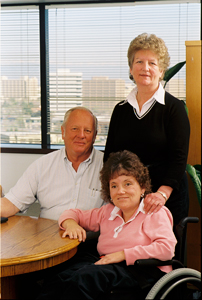
Planning Your Future

Should the air pressure in a plane drop, making it difficult to breath, airline staff instruct you to place an oxygen mask around your own nose and mouth before you do the same for your child. That is, care for yourself first so you can care for your child.
The same concept holds true when it comes to your financial future—plan for yourself first so you can plan for your child.
Through saving in special accounts designed to provide income during your retirement years and tending to some legal matters, you can create your own income stream during retirement, and then later, for your child.
Borrowing Against the Future
In some cases, you can use your retirement savings as a safety net for present financial needs. Certain conditions apply, but if necessary, you may be able to borrow money from certain retirement accounts. Some types of accounts allow you to borrow or withdraw money for medical purposes.
But borrow very cautiously, for two reasons.
- You must pay borrowed money back. If you don’t, you pay heavy fees and income tax on the borrowed money.
- Not paying borrowed money back can seriously jeopardize your retirement income.
Before you borrow from any retirement account, be sure you understand what fees you’ll incur, if any, and the consequences, in dollar amounts, for not paying borrowed money back: fees, taxes, and lost retirement income.
Learn More About Retirement Planning
A lot of decisions go in to making a retirement plan, saving for it, then actually retiring. The types of decisions you make about your house, work, investments, insurance, social security, and debt all affect your retirement income, or the amount of your monthly “retirement paycheck” after you retire. The resources listed below provide information to help you:
- Identify what decisions you need to make around retirement
- Learn about the types of retirement plans available
- Understand how each type of retirement plan works
- Understand the rules that govern each plan
IRS.gov
Call 1-800-829-1040 (Voice) or 1-800-829-4059 (TDD)
Visit www.irs.gov and search on the “Retirement Plans Community” tab, then click “Plan Participant/ Employee”
MyRetirementPaycheck.org
Visit www.MyRetirementPaycheck.org
Profit Sharing/401k Council of America
Call 312-419-1863
Visit www.401k.org/
Write
Profit Sharing/401k Council of America
20 N. Wacker Drive, Suite 3700
Chicago, IL 60606
Types of Retirement and Savings Programs
You have several options for saving for retirement. From Social Security Benefits to employer-provided 401(k) plans to your own investments, a lot of ground is covered in this section. Yet understanding all of your retirement savings and retirement income options may inspire you to either start saving or save even more.
Social Security
If you pay into the Social Security system as a wage earner, you will receive a portion of the money you need to retire. Social Security is not intended to provide all of your retirement income needs. How much of a retirement benefit you receive from Social Security depends on how much and how long you paid into the system through payroll deductions or, if self-employed, through quarterly tax payments.
Your Social Security Statement
If you are 25 years of age or older, and have paid into the Social Security system as a wage earner, you should receive a Social Security statement every year. Your statement should arrive about three months before your birth month. It will list your retirement benefits, your earnings record, and information on how your benefits are estimated. This information can help you plan for the future.
How Your Retirement Age Affects Your Retirement Income
Make special note in your Social Security Statement in the difference in your monthly income should you retire at the earliest possible age of 62, compared to retiring at age 66 or 67 (depending on when you were born), or even later.
This is an important distinction.
Note that if you begin collecting benefits at age 62, you permanently reduce your monthly income. That means you will never be able to collect the full monthly income benefit you are entitled to collect. You can only collect that full income benefit if you retire at age 66 or 67, or later.
How to Request Your Social Security Statement
If you are over 25 years of age or older, and have paid into the Social Security System but are not receiving a statement of benefits every year, contact the Social Security Administration and request a copy of Your Social Security Statement, Form SSA-7004-SM:
Call 1-800-772-1213 (Voice) or 1-800-325-0778 (TTY)
Visit www.socialsecurity.gov/mystatement
Write
Social Security Administration
Office of Earnings Operations
P.O. Box 33026
Baltimore, MD 21290-3026
Information You Will Need to Request Your Social Security Statement
Have ready the following information to complete a request for Your Social Security Statement:
- Your name as shown on your Social Security Card
- Your Social Security Number
- Your date of birth
- Your place of birth
- Your mother's maiden name (last name only; to help identify you)
If You Need to Correct Information on Your Social Security Statement
If any of your personal information or income listed in your earnings record is incorrect, contact Social Security using the information above and request Form 8822. Complete the form and mail it back to the address specified on the form. You can also correct your information online at www.socialsecurity.gov/mystatement .
Employer Plans

As part of your employment benefits package, some employers provide a way for you to save for and invest in your retirement. The money you save or invest in employer retirement plans accumulates tax-free until you retire and begin withdrawing money from the plan.
For some employer plans, saving and investing in them can lower your taxable income. Each type of employer plan is presented below.
Defined Benefits Plans
In years past, many companies paid the costs of pension plans for their workers under a program called a “defined benefit plan.” This retirement plan pays you a fixed amount (the defined benefit) each month during retirement. How much you receive depends on how long you worked for the company and how much you earned before you retired.
Although defined benefit plans are not as common in the private sector any more, many employees who work in the public sector (federal, state, or local governments) still receive “defined benefits” at retirement. However, even those plans are changing for some public sector employees, including newer ones who are being enrolled in defined contribution plans.
Defined Contribution Plans
Today, as part of an employee’s benefit package, many companies offer a “defined contribution” plan instead. For this type of retirement plan, you contribute a fixed amount (the defined contribution), usually a percentage of your income. Employers typically offer retirement plan workshops for employees so they can learn:
- How the plans work
- The tax benefits they offer
- How to transfer funds after a change of jobs
- How to begin withdrawing the funds at retirement
Employers will also inform employees on the types of investments they can make in their defined contribution plans, and the level of risk associated with each investment. Which investment(s) employees choose in their defined contribution plans is left to each employee. That way, employees can choose investments with risk levels they are comfortable with.
Types of Defined Contribution Plans
Three common types of defined contribution plans you may hear references to are:
- 401(k) (For-profit companies)
- 403(b) (Non-profit organizations)
- SIMPLE (Savings Incentive Match Plan for Employees)
Contribution Amounts
Employees may choose what amount they want to contribute to their retirement plans, usually one to six percent of their income. For example, if you earn $60,000 and contribute five percent of your income to a defined contribution plan, you will save $3,000 each year. There are limits to the amount you can contribute each year. For example, with SIMPLE, you can contribute up to $6,000 each year.
Matching Contributions
Some employers provide the employee benefit of matching your retirement plan contributions. While employer matching contributions are regulated by the Employee Retirement Income Security Act of 1974 (ERISA), each employer is able to decide by how much it will match employee retirement plan contributions. Typically, employers base their matching contributions on a certain percentage of your:
- Income. For example, your employer may base matching contributions on 50 percent of your income. From the income example above of $60,000, this means your employer’s matching contributions would be based on $30,000.
- Contributions. For example, your employer may base matching contributions on one percent of your contributions. From the contribution percentage example above of five percent, or $3,000, this means your employer’s matching contribution would be based on one percent, or $600.
If you take into account that your employer’s matching is based on only 50 percent of your income, this means your employer’s matching contribution would be $300, or one percent of $30,000.
(see Hilary Z. Simpson. “Compensation and Working Conditions--“How Does Your 401(k) Match Up?” Bureau of Labor Statistics. May 26, 2010)
Employers are also able at their discretion to suspend or reduce matching employee retirement plan contributions, for example, in challenging economic times. But for any matching your employer does provide, at any level, consider it a valuable employee benefit. It is like getting free money.
Vesting
When it comes to your retirement plan, vesting means “ownership.” Your contributions to an employee retirement plan are always vested (see IRS.gov. “Retirement Topics—Vesting.” Page last reviewed August 5, 2010. Retrieved from https://www.irs.gov/retirement-plans/plan-participant-employee/retirement-topics-vesting on November 19, 2010.), meaning that you always “own” them—you never have to give them back. Should you change jobs, you can transfer the amount of your contributions from your “old” retirement plan to a new one or directly to a rollover IRA.
Sometimes employers’ contributions may become immediately vested. This means that you own them as soon as you start receiving them. In other cases, employer contributions may follow a phased-in vesting period based on your years of service. For example, you may own, or become vested in, a certain percentage of your employer contributions after one year of work, a higher percentage after two years of work, and so on until you own, or become fully vested in, all of your employer’s matching contributions.
Vesting periods for employer contributions vary at each company, but they generally last three to six years (see IRS.gov. “The Fix Is In: Common Plan Mistakes - Vesting Errors in Defined Contribution Plans” Retrieved https://www.irs.gov/retirement-plans/plan-sponsor/fixing-common-plan-mistakes-vesting-errors-in-defined-contribution-plans from on November 19, 2010.) and have a phased-in ownership schedule. If you were to change jobs before the full vesting period is over, you would be able to transfer only the vested employer contributions (the amount you “own”) to a new retirement plan. Check with your employee benefits staff to find out how long your company’s vesting period is.
How Retirement Plan Contributions Affect Your Take-Home Pay
When you contribute to your employee retirement plan, you divert a portion of your income into retirement savings, away from your take-home pay. From the example above, still assuming your annual income is $60,000, your $3,000 contribution to your retirement plan would reduce your gross (before taxes) take-home pay to $57,000.
The Tax Benefits
Lowering your take-home pay may not sound all that appealing, but you get two tax benefits for making the sacrifice:
- Tax-deferred earnings. The money you contribute to and invest in your defined contribution plan grows tax free until you retire and begin withdrawing money from the plan. At that point, you begin paying income tax on the withdrawals. In other words, your taxes are “deferred” to a later time, when your income tax rate might be lower than when you were working.
- A lower taxable income. Because your contributions are not taxed now, but later, your taxable income is lowered by the amount of your contributions. For example, if you earn $60,000 and contribute five percent, or $3,000, to your defined contribution plan, your taxable income is $57,000. In other words, you would calculate your annual income tax on $57,000, not $60,000.
Investment Choice
Your employer will provide you with a choice of investments you can make in your defined contribution plan, usually money market, mutual funds, stocks, and bonds.
Penalty for Early Withdrawals
If you withdraw money from your defined contribution plan before 59 years of age, the earliest age you may withdraw, you will pay a 10 percent penalty fee on the amount of the early withdrawal in addition to income tax on the withdrawn amount.
Exceptions: Hardship Withdrawals
Some employer retirement plans allow for hardship withdrawals, penalty-free, for medical expenses not covered by your health care plan. Check with your employer on whether this is the case with your retirement plan. Some pretty strict requirements usually have to me met to qualify for a hardship withdrawal. To avoid a potentially costly error, be clear on what your financial responsibilities are before you make an actual withdrawal. Employers may also allow the hardship withdrawals listed below (see GuideTo401kHardships.com . “Information on 401(k) Hardship Withdrawals.” Retrieved from http://www.guideto401khardships.com/ on September 7, 2010). Again, be clear on what requirements you must meet before you make any withdrawals from your employer retirement plan.
- Un-reimbursed medical expenses
- The purchase of your first home (the one you would live in; not a rental or investment home)
- Payment of college tuition and some related costs, such as room and board
- Payments on your primary residence (not rental or investment property) to prevent eviction or foreclosure
- Funeral expenses
- The repair of your primary residence
Important Considerations for Hardship Withdrawals
Making a hardship withdrawal may have several implications on the long-term financial well-being of you, your family, and your child with ongoing special needs. Consider them carefully (see IRS.gov. “Retirement Topics—Hardship Distributions.” Page last reviewed August 5, 2010. Retrieved from https://www.irs.gov/retirement-plans/plan-participant-employee/retirement-topics-hardship-distributions on November 19, 2010, and IRS.gov. “Retirement Plans FAQs regarding Hardship Distributions.” Retrieved from https://www.irs.gov/retirement-plans/retirement-plans-faqs-regarding-hardship-distributions on November 19, 2010.).
- You will have to pay income tax on the amount withdrawn from your employee retirement plan.
- You reduce the amount of your retirement savings by the amount withdrawn.
- You may withdraw only your contributions, not your employer’s matched contributions.
- The withdrawal may not be higher than the hardship expense. For example, it may not be more than the actual unreimbursed medical expenses.
If you’re strapped for cash, a hardship withdrawal might seem like the answer to your financial hardship. But consider the long-term consequences.
First, do you want to potentially reduce your retirement income? And second, do you expect your financial situation to improve? If you don’t think it will, what is the possibility of finding yourself strapped for cash again?
If you think your financial situation might improve and you are not contributing the maximum amount allowable to your retirement plan, you may have the opportunity to “pay yourself back” by making higher contributions in the future.
Catch-Up Contributions
The IRS allows individuals age 50 and over to make annual “catch-up” contributions to their employee retirement plans. The IRS limits the amount of catch-up contributions. As of 2010, the annual limit is $5,500. Other restrictions to making catch-up contributions apply. For more information on catch up contributions, take a look at the IRS article Retirement Topics—Catch-Up Contributions. It is very important you fully understand every financial consequence to a hardship withdrawal. If you are considering one, speak to someone at your company knowledgeable about them. Also, visit the IRS Web site and take a look at the article, Retirement Topics—Hardship Distributions.
Profit-Sharing Plans

Your employer may offer to share its profits, often by contributing company stock or cash into a profit sharing account, in your name. The contributions grow tax-deferred, and you don’t pay income tax on the contributions until you withdraw them at retirement.
If you receive company stock, the value of your profit sharing plan will rise and fall as the price of the company stock fluctuates over time. Remember to keep in mind the importance of diversifying your investments—to not invest too heavily in any one type of investment or particular stock. You might have heard this rule of thumb referred to as “Don’t put all of your eggs in one basket.”
In addition, your employer does not have to share its profits year after year. Think of your profit-sharing plan as a bonus rather than as a resource for your retirement or for your child’s needs.
For more information on profit sharing plans,
Call 312-419-1863
Visit the Profit Sharing/401k Council of America at www.401k.org .
Next Section: Individual Retirement Accounts (IRAs)
